

Reinforcement and Punishment. Learning Objectives.
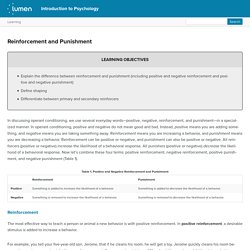
Positive Reinforcement - Tips for teaching and parenting. Using Positive Reinforcement to Improve Behavior. When your child misbehaves, rewards might be the last thing on your mind.
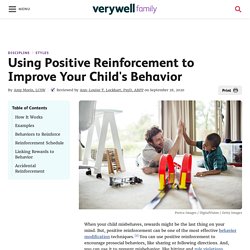
But, positive reinforcement can be one of the most effective behavior modification techniques.1 You can use positive reinforcement to encourage prosocial behaviors, like sharing or following directions. And, you can use it to prevent misbehavior, like hitting and rule violations. Positive reinforcement can also be an effective way to encourage and motivate your child to be responsible, do their chores, get along with their siblings, or complete their homework assignments without arguing. Positive Reinforcement Is Worth A Shot, And Here's Why. Hands down, one of the hardest things about being a parent is figuring out how to effectively discipline your kids.

Ten years into this parenting thing, and I will freely admit that I don’t have it all figured out. I never will. It seems like one particular method will work for a little while, and then my kids will turn around and test the limits in a completely different way. Plus, both of my kids have strikingly different personalities, and what works for one just won’t work at all for the other.
The way I discipline my kids is part instinct, part theory, and part crossing my fingers and praying that they’ll freaking listen to me and I won’t screw them up too badly in the process. More and more in my parenting journey, I’ve been adopting the theory of “positive reinforcement,” when it comes to discipline — and I’ve consistently seen pretty remarkable results.
Besides verbal praise, positive reinforcement can also come in the form of rewards and gifts. Using Positive Reinforcement. How to Reward Your Teen for Good Behavior. Teenagers are young adults who are trying to learn the ways of the world.
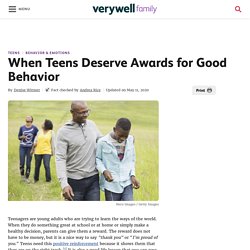
When they do something great at school or at home or simply make a healthy decision, parents can give them a reward. The reward does not have to be money, but it is a nice way to say "thank you" or "I'm proud of you. " Teens need this positive reinforcement because it shows them that they are on the right track.1 It is also a good life lesson that you can pass on: good things happen to good people. When Do Teenagers Deserve a Reward? What is Negative Reinforcement? Negative reinforcement: Definition and examples. Negative reinforcement encourages specific behaviors by removing or avoiding negative consequences or stimuli.

It is different than punishment, which aims to discourage a specific behavior. Negative reinforcement has become a popular way of encouraging good behavior at school. Keep reading to learn more about how it works and how it differs from positive reinforcement and punishment. Negative reinforcement is the encouragement of certain behaviors by removing or avoiding a negative outcome or stimuli. People typically use this technique to help children learn good patterns of behavior, but it can also play a role in training animals and pets. Examples of Negative Reinforcement.
Negative Reinforcement and Operant Conditioning. Negative reinforcement is a term described by B.
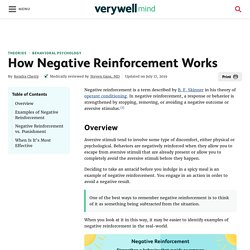
F. Skinner in his theory of operant conditioning. In negative reinforcement, a response or behavior is strengthened by stopping, removing, or avoiding a negative outcome or aversive stimulus.1 Overview Aversive stimuli tend to involve some type of discomfort, either physical or psychological. The Study of Punishment in Psychology. Punishment is a term used in operant conditioning to refer to any change that occurs after a behavior that reduces the likelihood that that behavior will occur again in the future.

While positive and negative reinforcements are used to increase behaviors, punishment is focused on reducing or eliminating unwanted behaviors. Punishment is often mistakenly confused with negative reinforcement. Positive Punishment Types and Examples. What is Negative Punishment (Examples and Effectiveness) In this article, we will review negative punishment, its definition, examples, and drawbacks.

American psychologist B.F. Skinner developed the theory of operant conditioning, which stated that a person or animal’s behavior could be increased or decreased by adding or removing appropriate stimuli after the behavior is exhibited. How Negative Punishment Works. Negative punishment is an important concept in B.
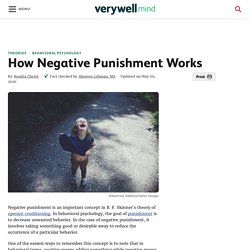
F. Skinner's theory of operant conditioning. In behavioral psychology, the goal of punishment is to decrease unwanted behavior. In the case of negative punishment, it involves taking something good or desirable away to reduce the occurrence of a particular behavior. One of the easiest ways to remember this concept is to note that in behavioral terms, positive means adding something while negative means taking something away. Difference Between Positive and Negative Punishment. Effective Consequences for Teenagers. If you’re having trouble giving effective consequences to your teen, know that you are not alone.

Many parents tell me that nothing seems to work, and that coming up with the right thing for their child can seem like an impossible task. If you’re the parent of an adolescent, you may have grounded your child, taken away their video games, or suspended their driving privileges for months on end. But as James Lehman says, you can’t punish kids into acceptable behavior—it just doesn’t work that way. “You can’t punish kids into acceptable behavior.” Rather, an effective consequence should encourage your child to change his behavior — whether that is abiding by the house rules, or treating people respectfully. For example, if your child swears when she doesn’t get her way, you want her to behave more appropriately.
Let’s break this down according to The Total Transformation Program: Effective consequences are ones that are connected to the original behavior and are both task- and time-specific. Reinforcement vs. Punishment: Changing Behavior. Being a parent has been known as the best thing ever BUT also the most challenging endeavor you will encounter in your lifetime. Parents strive to raise a healthy and happy child that will one day grow up as a full-fledged mature and independent adult. But to successfully accomplish this goal, a parent must set forth structure or rules throughout their childhood to help them understand and be realigned when their behavior needs to be modified. When a parent recognizes the need to change a behavior, they will likely end up using either reinforcement, punishment, or a mixture of both. When we’re helping to decrease the frequency of a child’s negative behavior, having the reinforcement or punishment methods in our toolkit can help you modify and implement the desired behavior.
12 Examples of Positive Punishment & Negative Reinforcement. You might be thinking that “positive punishment” sounds like an oxymoron, after all, how can punishment be positive? Not many people “like” punishment, right? The disconnect in understanding this concept comes from the usage of the word “positive;” here at PositivePsychology.com, we generally use the term “positive” to refer to things that are inherently good, things that are life-giving, and things that promote thriving and flourishing. The concept of positive punishment comes from a very different era and a very different perspective on psychology; namely, the 1930s and behaviorism. So, what actually is positive punishment and how does it relate to parenting, teaching, and even the workplace?
Before you read on, we thought you might like to download our 3 Positive Psychology Exercises for free. You can download the free PDF here. Positive vs Negative Reinforcement: Which Is More Effective? Table of Content: 1. What is Reinforcement? 2. What are the different types of Reinforcement? 3. Last week, our company started a healthy competition between us. That’s when I realized how productive we ended up being for the given week. But, why? Why did this happen? Positive Reinforcement vs. Punishment: Which is more EFFECTIVE? Psychology: What is Classical Conditioning? What is Operant Conditioning? The difference between classical and operant conditioning - Peggy Andover. Operant Conditioning - Negative Reinforcement vs Positive Punishment.